A High-Resolution Electric Current Sensor Employing a Piezoelectric Drum Transducer
Abstract
:1. Introduction
2. Design and Analysis
3. Results and Discussion
4. Conclusions
Funding
Data Availability Statement
Conflicts of Interest
References
- Yi, L.; Lin, F.; Qin, Z.; Zhong, H. Design and construction of a Rogowski coil for measuring wide pulsed current. IEEE Sens. J. 2011, 11, 123–130. [Google Scholar]
- Cataliotti, A.; Di Cara, D.; Emanuel, A.E.; Nuccio, S. Improvement of Hall effect current transducer metrological performances in the presence of harmonic distortion. IEEE Trans. Instrum. Meas. 2010, 59, 1091–1097. [Google Scholar] [CrossRef]
- Ziegler, S.; Woodward, R.C.; Iu, H.C.; Borle, L.J. Current sensing techniques: A review. IEEE Sens. J. 2009, 9, 354–376. [Google Scholar] [CrossRef]
- Leland, E.S.; Wright, P.K.; White, R.M. A MEMS AC current sensor for residential and commercial electricity end-use monitoring. J. Micromech. Microeng. 2009, 19, 094018. [Google Scholar] [CrossRef] [Green Version]
- Zhu, Y.; Zu, J.W. A magnetoelectric generator for energy harvesting from the vibration of magnetic levitation. IEEE Trans. Magn. 2012, 48, 3344–3347. [Google Scholar] [CrossRef]
- Bai, X.; Wen, Y.; Yang, J.; Li, P.; Qiu, J.; Zhu, Y. A magnetoelectric energy harvester with the magnetic coupling to enhance the output performance. J. Appl. Phys. 2012, 111, 07A938. [Google Scholar] [CrossRef]
- Li, M.; Wen, Y.; Li, P.; Yang, J. A resonant frequency self-tunable rotation energy harvester based on magnetoelectric transducer. Sens. Actuators A 2013, 194, 16–24. [Google Scholar] [CrossRef]
- Dai, Z. An vibration energy harvester with broadband and frequency-doubling characteristics based on rotary pendulums. Sens. Actuators A. 2016, 241, 161–168. [Google Scholar] [CrossRef]
- He, W.; Qu, C. A magnetically levitated magnetoelectric vibration generator using a Halbach array. Sens. Actuators A 2020, 315, 112301. [Google Scholar] [CrossRef]
- Zhang, J.; Li, P.; Wen, Y.; He, W.; Yang, A.; Lu, C.; Qiu, J.; Wen, J.; Yang, J.; Zhu, Y.; et al. High-resolution current sensor utilizing nanocrystalline alloy and magnetoelectric laminate composite. Rev. Sci. Instrum. 2012, 83, 115001. [Google Scholar] [CrossRef]
- Zhang, J.; Li, P.; Wen, Y.; He, W.; Yang, A.; Lu, C. Packaged current-sensing device with self-biased magnetoelectric laminate for low frequency weak-current detection. Smart Mater. Struct. 2014, 23, 095028. [Google Scholar] [CrossRef]
- Zhang, S.; Leung, C.M.; Kuang, W.; Or, S.W.; Ho, S.L. Concurrent operational modes and enhanced current sensitivity in heterostructure of magnetoelectric ring and piezoelectric transformer. J. Appl. Phys. 2013, 113, 17C733. [Google Scholar] [CrossRef] [Green Version]
- Zhan, S.; Tong, Y.; Deng, S.; Xue, H.; Yang, S.; Lu, Y.; Wang, C.; Liu, X. Magnetoelectric sensor with miniature universal tunable bias magnetic circuit. Appl. Phys. Lett. 2013, 103, 032903. [Google Scholar]
- Leung, C.M.; Or, S.W.; Zhang, S.; Ho, S.L. Ring-type electric current sensor based on ring-shaped magnetoelectric laminate of epoxy-bonded Tb0.3Dy0.7Fe1.92 short-fiber/NdFeB magnet magnetostrictive composite and Pb (Zr, Ti) O3 piezoelectric ceramic. J. Appl. Phys. 2010, 107, 09D918. [Google Scholar] [CrossRef] [Green Version]
- Yu, X.; Lou, G.; Chen, H.; Wen, C.; Lu, S. A slice-type magnetoelectric laminated current sensor. IEEE Sens. J. 2015, 15, 5839–5850. [Google Scholar] [CrossRef]
- Zhang, M.; Or, S.W. Gradient-type magnetoelectric current sensor with strong multisource noise suppression. Sensors 2018, 18, 588. [Google Scholar] [CrossRef] [Green Version]
- Lu, C.; Li, P.; Wen, Y.; Yang, A.; Yang, C.; Wang, D.; He, W.; Zhang, J. Zero-biased magnetoelectric composite Fe73.5Cu1Nb3Si13.5B9/Ni/Pb (Zr1-x, Tix)O3 for current sensing. J. Alloys Compd. 2014, 589, 498–501. [Google Scholar] [CrossRef]
- He, W.; Zhang, J.; Qu, C.; Wu, J.; Peng, J. A passive electric current sensor based on ferromagnetic invariant elastic alloy, piezoelectric ceramic, and permalloy yoke. IEEE Trans. Magn. 2016, 52, 4001504. [Google Scholar] [CrossRef]
- Olszewski, O.Z.; Houlihan, R.; O’Keeffe, R.; O’Neill, M.; Waldron, F.; Mathewson, A.; Jackson, N. A MEMS silicon-based piezoelectric AC current sensor. Procedia Eng. 2014, 87, 1457–1460. [Google Scholar] [CrossRef] [Green Version]
- He, W.; Lu, Y.; Qu, C.; Peng, J. A non-invasive electric current sensor employing a modified shear-mode cymbal transducer. Sens. Actuators A 2016, 241, 120–123. [Google Scholar] [CrossRef]
- He, W.; Yang, A. A shear-mode piezoelectric heterostructure for electric current sensing in electric power grids. Micromachines. 2019, 10, 421. [Google Scholar] [CrossRef] [PubMed] [Green Version]
- Min, Z.; Or, S.W.; Chan, H.L.W. Giant resonance frequency tunable magnetoelectric effect in a device of Pb(Zr0.52Ti0.48)O3 drum transducer, NdFeB magnet, and Fe-core solenoid. Appl. Phys. Lett. 2010, 96, 203502. [Google Scholar]
- Challa, V.R.; Prasad, M.G.; Shi, Y.; Fisher, F.T. A vibration energy harvesting device with bidirectional resonance frequency tenability. Smart Mater. Struct. 2008, 17, 015035. [Google Scholar] [CrossRef]
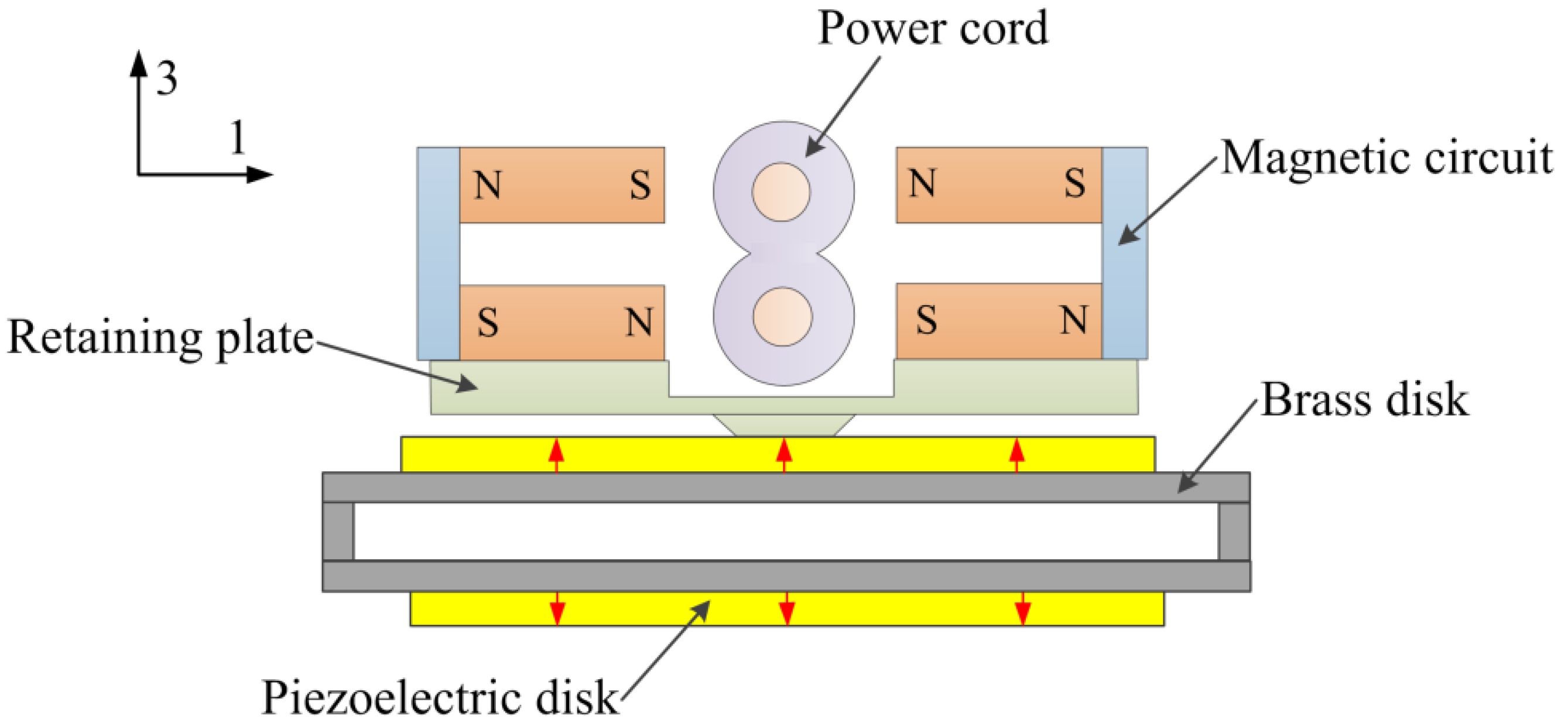
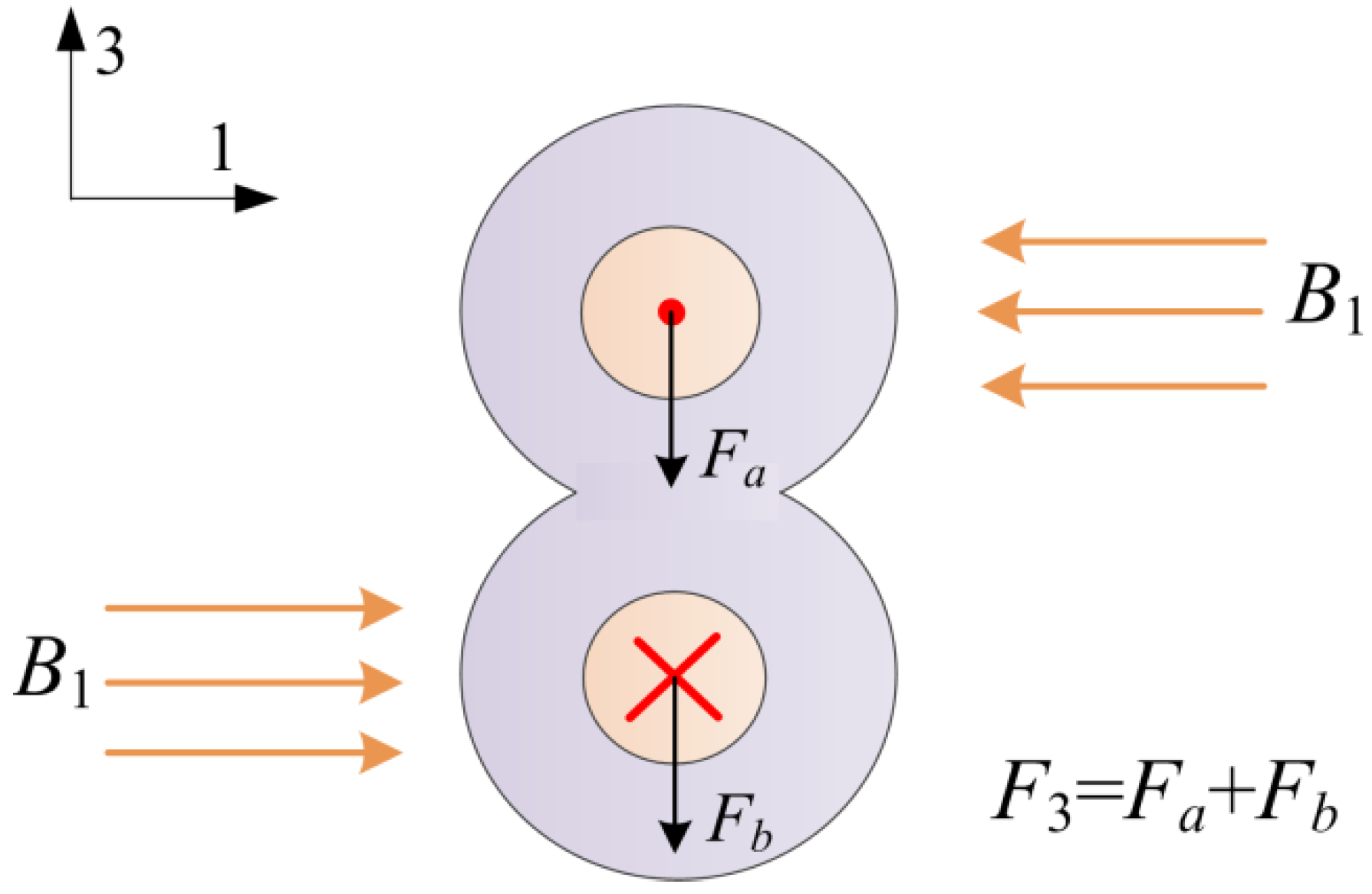

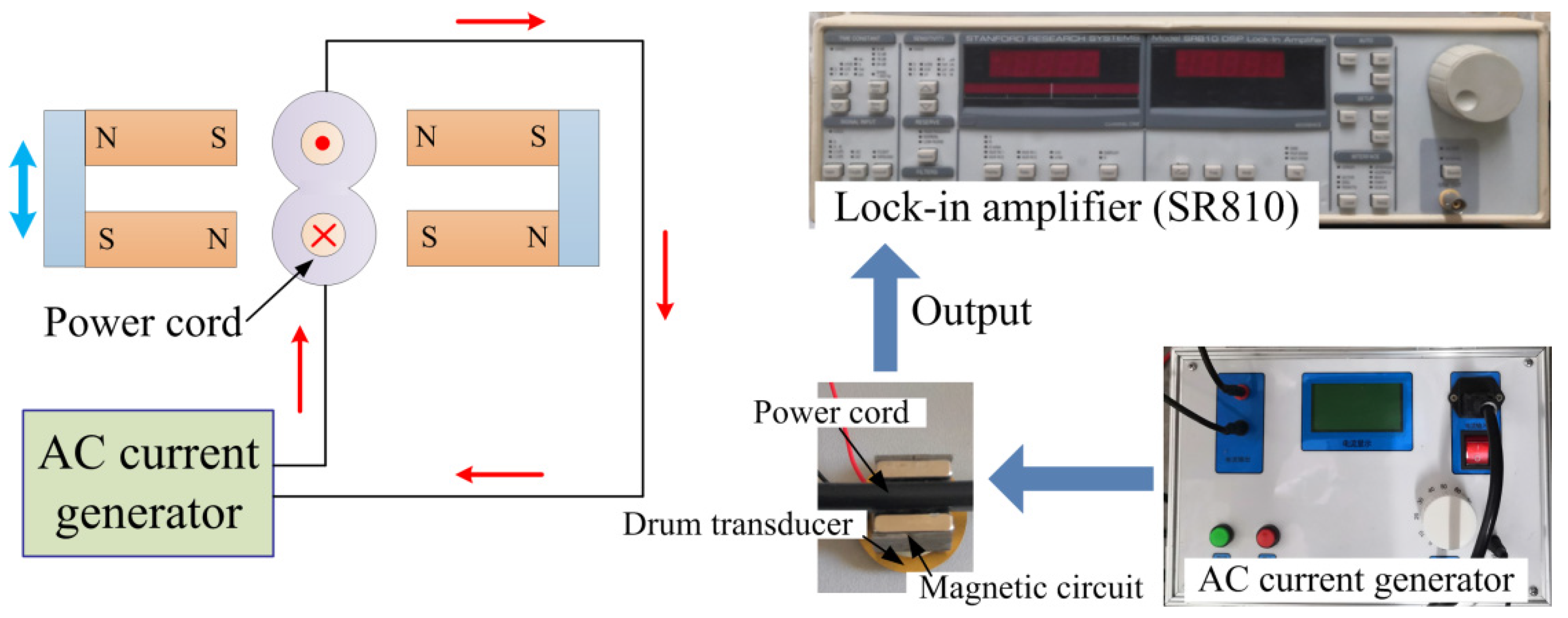
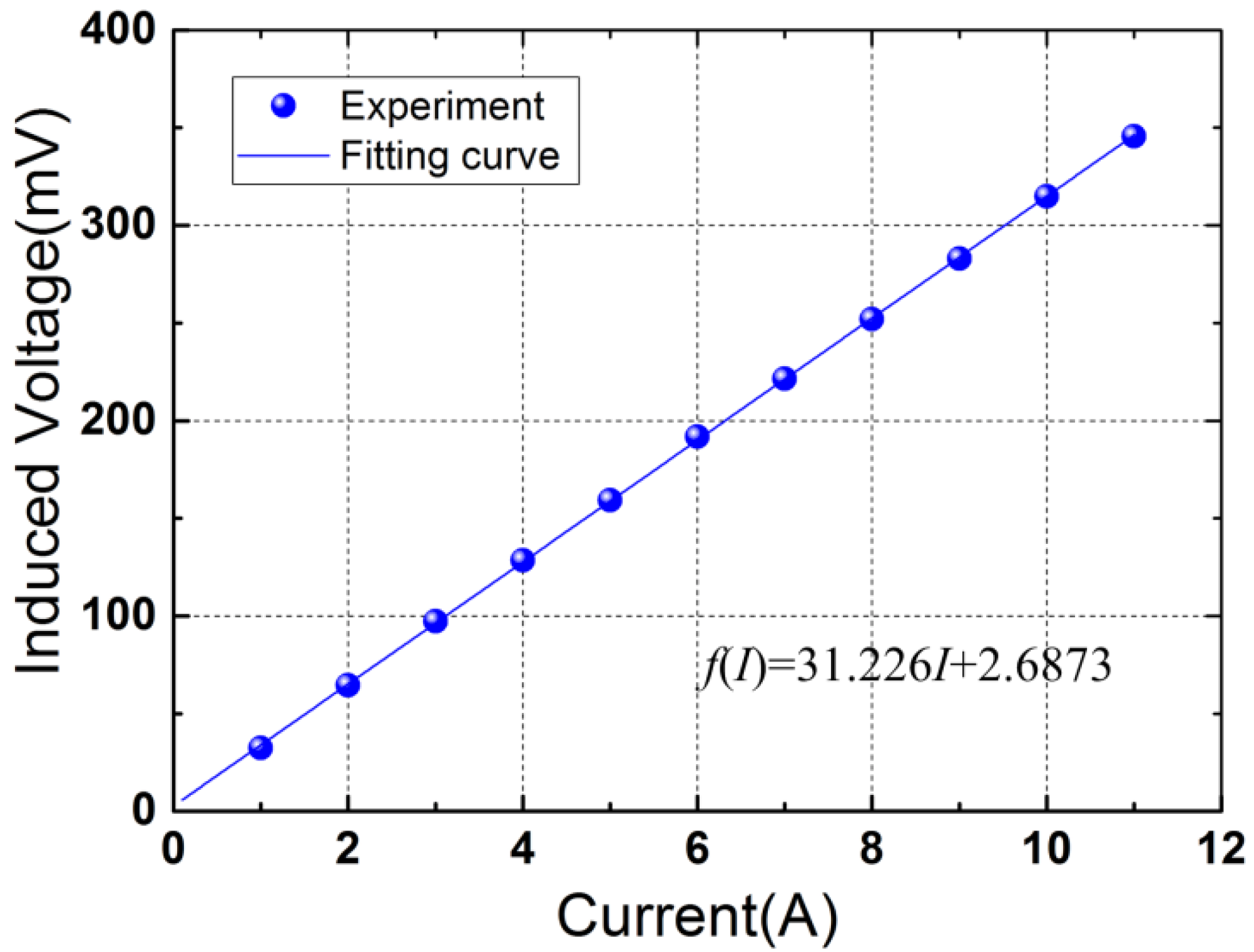

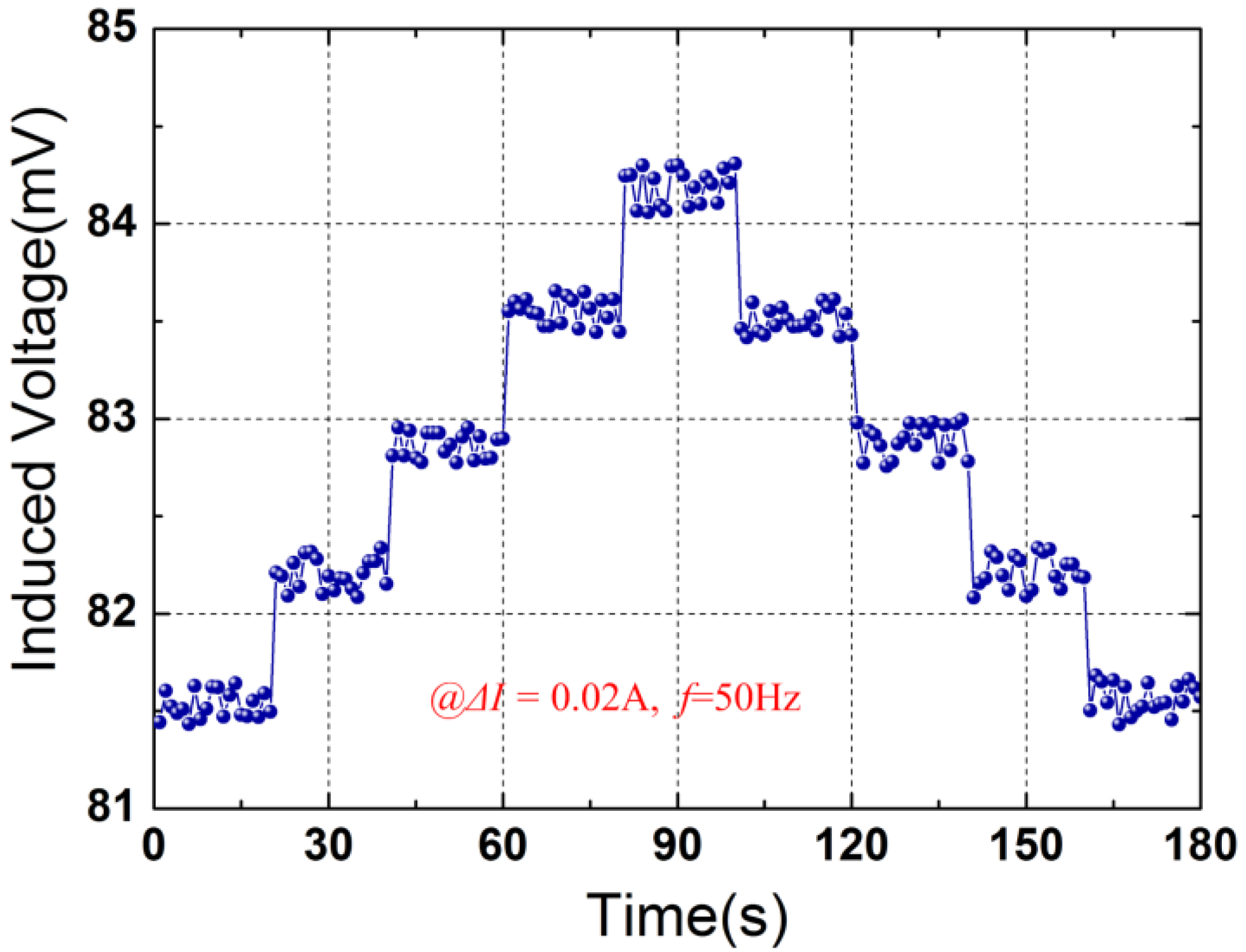

Publisher’s Note: MDPI stays neutral with regard to jurisdictional claims in published maps and institutional affiliations. |
© 2021 by the author. Licensee MDPI, Basel, Switzerland. This article is an open access article distributed under the terms and conditions of the Creative Commons Attribution (CC BY) license (https://creativecommons.org/licenses/by/4.0/).
Share and Cite
He, W. A High-Resolution Electric Current Sensor Employing a Piezoelectric Drum Transducer. Micromachines 2021, 12, 1166. https://doi.org/10.3390/mi12101166
He W. A High-Resolution Electric Current Sensor Employing a Piezoelectric Drum Transducer. Micromachines. 2021; 12(10):1166. https://doi.org/10.3390/mi12101166
Chicago/Turabian StyleHe, Wei. 2021. "A High-Resolution Electric Current Sensor Employing a Piezoelectric Drum Transducer" Micromachines 12, no. 10: 1166. https://doi.org/10.3390/mi12101166





